
 |
The cherry blossom is Japan's national flower. The advent of the cherry blossom season between late March and early April not only heralds the coming of spring but the beginning of the new academic year for schools and of the new fiscal year for businesses. During this period, the weather authorities at the Meteorological Agency report on the advance of the sakura zensen, " the cherry blossom front, " as warm weather moves northward, and people begin to look forward with anticipation to its arrival and the true end of winter's cold that it signals. As the trees begin to bloom, people gather beneath them to enjoy the flowers. The Japanese cherry blossoms open all at once and the petals fall after a relatively short span, about one week or 10 days, and their very delicacy and transience have poignant and poetic appeal. In this issue, we look at this best-loved of flowers in Japan and the events and artifacts that express this appeal. The Japanese cherry blossoms open all at once and the petals fall after a relatively short span, about one week or 10 days, and their very delicacy and transience have poignant and poetic appeal. In this issue, we look at this best-loved of flowers in Japan and the events and artifacts that express this appeal.
|
|
History of Hanami In the ancient period, flower viewing -- hanami -- referred to enjoying the blossoms of the Japanese apricot -- ume, but since the Heian period ( 794 - 1185 ) it has meant cherry-blossoms. Originally a religious ritual, the hanami was held on a particular day. With the coming of spring it was customary to perform ceremonies prior to the beginning of planting, forecasting the harvest for the year from the condition of the cherry blossoms. Then, likening the cherry trees in full bloom to a bumper harvest of rice, they would celebrate with food and drink under the trees. In those days it was a tradition observed only by the nobility and upper classes.  From medieval times, the way cherry petals fall at the height of their beauty ( that is, before they have withered and become unsightly ) and the transcience of their span assumed symbolism both in the warrior code and in Buddhism. Soon the cherry blossoms became an expression of the samurai way of life. The custom of hanami spread to the warrior class, and the warlord Toyotomi Hideyoshi ( 1537 - 98 ), who played a major role in the unification of the country, held historically grand hanami to flaunt his power. Cherry blossom parties spread to commoners in the era of cultural ferment toward the end of the seventeenth century known as Genroku ( 1688 - 1704 ). Families, groups of friends, or workmates would gather for merry feasting and drinking. From medieval times, the way cherry petals fall at the height of their beauty ( that is, before they have withered and become unsightly ) and the transcience of their span assumed symbolism both in the warrior code and in Buddhism. Soon the cherry blossoms became an expression of the samurai way of life. The custom of hanami spread to the warrior class, and the warlord Toyotomi Hideyoshi ( 1537 - 98 ), who played a major role in the unification of the country, held historically grand hanami to flaunt his power. Cherry blossom parties spread to commoners in the era of cultural ferment toward the end of the seventeenth century known as Genroku ( 1688 - 1704 ). Families, groups of friends, or workmates would gather for merry feasting and drinking. Today, hanami is no more than a private, popular opportunity for having a good time. Today, hanami is no more than a private, popular opportunity for having a good time. | ||
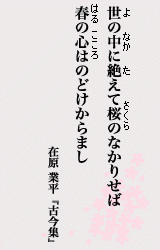 |
Yo no naka ni Taete sakura no Taete sakura no nakariseba nakarisebaHaru no kokoro wa  Nodoke karamashi Nodoke karamashiIf there were no  cherry blossoms cherry blossoms in this world in this worldHow much more tranquil  our hearts would be in spring. our hearts would be in spring.( Ariwara no Narihira, Kokinshuu ) |
In other words, it is because of the unpredictability of the blooming and falling of the cherry blossoms that spring is such a time of agitation and excitement. |
Cherry blossoms in other countries In the early twentieth century ( in 1909 and 1912 ), Japan presented gifts of flowering cherry trees to the United States as symbols of goodwill, and these were planted in Washington, D.C., where they are now one of the most attractive sights of that city. In other countries, including the Republic of Korea, China, Australia, New Zealand, as well as countries in Europe and South America, the Japanese cherry blossom season can be enjoyed just as in Japan. |
||
Sakura zensen  The cherry blossom " front " 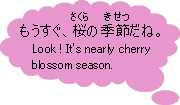 The line formed across the Japanese archipelago by the locations where the cherry blossoms have begun to open is called the sakura zensen, using the weather broadcasting term " front, " as in " cold front, " or " cherry blossom front. " The daily weather report on television includes news on where the sakura zensen stands and where the blossoms are out as well as when it can be expected to move further northward. ( People begin to plan their hanami as the date forecast for the opening of the cherry blossoms in their area nears. ) The sakura zensen map shown here shows the dates for the "cherry-blossom front" for 1999. As the front moves northward, we can hear the voices of people looking forward to its arrival.
The line formed across the Japanese archipelago by the locations where the cherry blossoms have begun to open is called the sakura zensen, using the weather broadcasting term " front, " as in " cold front, " or " cherry blossom front. " The daily weather report on television includes news on where the sakura zensen stands and where the blossoms are out as well as when it can be expected to move further northward. ( People begin to plan their hanami as the date forecast for the opening of the cherry blossoms in their area nears. ) The sakura zensen map shown here shows the dates for the "cherry-blossom front" for 1999. As the front moves northward, we can hear the voices of people looking forward to its arrival.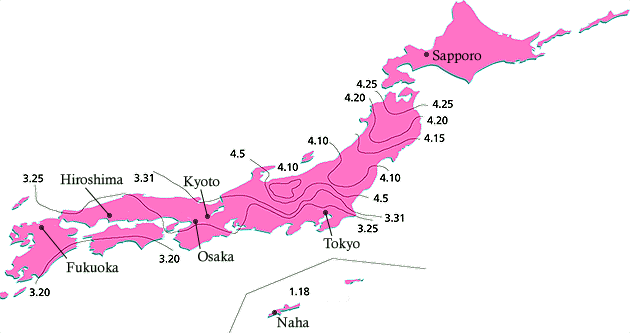
|
|
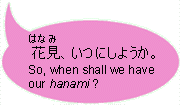 |
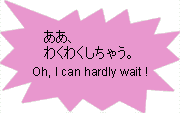 |
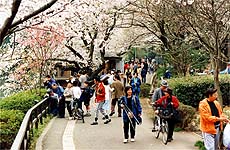 Photo : Hongo Jin |
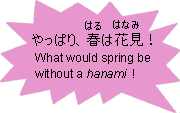 |
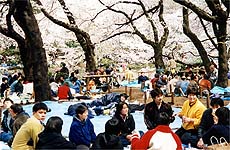 |
Hanami  Enjoying the cherry blossoms When the cherry blossoms bloom, people bring food and drink to places famous for flower viewing and spread out their picnics beneath the trees. |
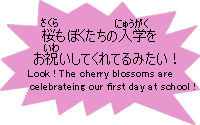 Nyuugakushiki Nyuugakushiki  Celebrating entrance to a new school In Japan, the school year begins in April, and so does the fiscal year for businesses. During this month, the cherry blossoms are in the full bloom of spring, heightening the experience of starting something new. Schools hold commencement ceremonies for new classes of entering first-year students. First-grade students receive a brand-new school satchel -- called a randoseru ( from Dutch, ransel ) -- from their parents or grandparents when they begin school. |
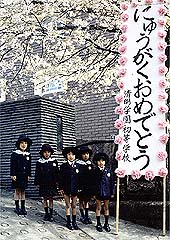 |
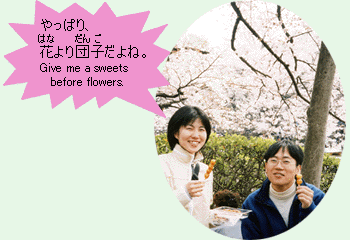 |
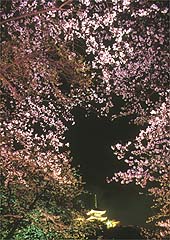 Photo : Hongo Jin |
|
Hana yori dango  " If I have to choose, I'd take food before flowers." Proverb that expresses the priority people give to things that are real and tangible in contrast to those that are abstract and difficult to grasp. 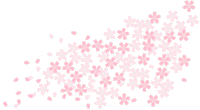 Sakura fubuki Sakura fubuki  Cherry blossom " snowstorm " When cherry blossom petals start falling heavily, the flurry blossoms are described as a "cherry snowstorm." |
Yozakura  Cherry blossoms at night After the sun goes down, the cherry blossoms cast pale shadows against the dark sky. Enjoying the flowers by night, too, is a special pleasure of the season. |
 Cherry blossoms can be found everywhere in Japanese life, as you can tell from the items shown here. Photographs and pictures 1 to 9 are cherry blossom related items. Can you tell what they are? What are they used for? What connection do they have with cherry blossoms? See if you can guess from the boxes below. Try to find related Japanese word for each item ( from A to I ), its English translation ( from a to i ), and explanations ( from J to R ), and fill the answer as shown in the example. Cherry blossoms can be found everywhere in Japanese life, as you can tell from the items shown here. Photographs and pictures 1 to 9 are cherry blossom related items. Can you tell what they are? What are they used for? What connection do they have with cherry blossoms? See if you can guess from the boxes below. Try to find related Japanese word for each item ( from A to I ), its English translation ( from a to i ), and explanations ( from J to R ), and fill the answer as shown in the example.click here for the answers |
example:    |
| ( Photos 1,2,3,4,6,8,9 : Hongo Jin ) |
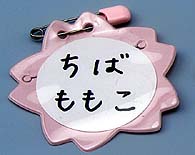 | 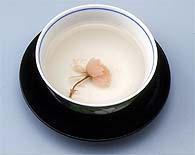 | 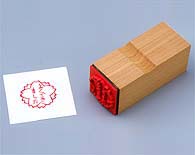 |
  |   |   |
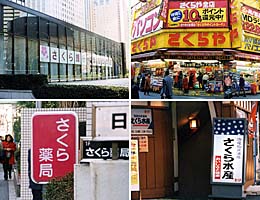 | 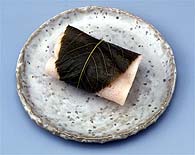 |
  |   |
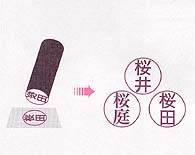 | 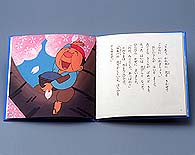 |
  |   |
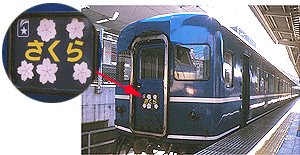 |
  |
A.  densha / B. densha / B.  kanban / C. kanban / C.  hanko / E. hanko / E. F.  mukashi banashi / G. mukashi banashi / G.  okashi / H. okashi / H.  stanpu / I. stanpu / I.  nafuda nafuda |
a. stamp / b. folk tale / c. name tag / d. drink / e. personal seal / f. money or coin / g. train / h. sign / i. confection |
|
J. Sakura-mochi : Seasonal Japanese confection ( wagashi ) for March and April. This one is made by rolling up a ball of sweet red-bean paste ( anko ) in a pancake made of flour paste dyed pink and then wrapping the whole in a salt-preserved cherry-tree leaf. K. Carved with the characters of the person's surname, they are used in place of a signature. Japanese names incorporating the character for sakura are fairly common, including Sakurai  ( " cherry well " ) Sakurada ( " cherry well " ) Sakurada  ( " cherry field " ), and Sakuraba ( " cherry field " ), and Sakuraba  ( " cherry garden " ). ( " cherry garden " ).L. The cherry tree motif, Japan's national flower, can be found carved on the back of 100 yen coins. M. The superexpress "Sakura" is a sleeper train that runs between Tokyo and Nagasaki in Kyushu. The front of the train is marked with a sakura motif. N. The Sakura Bank is one of Japan's largest banks. Its logo features the cherry blossom that is such a familiar symbol to all Japanese. The bank's image color, moreover, is pink. Another business that takes advantage of this motif is Sakuraya, a well-known chain of electric appliance discount shops. Many other kinds of shops, including drug stores and supermarkets, often use the name " Sakura. " O. Children at kindergartens usually wear a name tag; this kind of cherry-blossom-shaped, pink name tag holder is especially common. P. The kind-hearted old man, " Hanasaka-jiisan," became famous when he tossed ashes over a withered cherry tree and made the tree come into bloom. Q. Sakura-yu : This tea is made by steeping a salt-preserved cherry blossom in hot water. It is often served in place of regular green tea at weddings and other celebrations. R. Elementary school teachers often use stamps like this to mark their students' papers. Those who have done their assignments properly or finished a project can earn this badge of achievement. In the center of the cherry blossom motif are written the words " yoku deki mashita " ( " well done ! " ). | |
| Activity on Cherry Blossom |
| |||||
| ||||||
|
| answers | |||
| 2. I - c - O | 3. E - d - Q | 4. H - a - R | 5. B - h - N |
| 6. G - i - J | 7. D - e - K | 8. F - b - P | 9. A - g - M |
| Original text : The Japan Forum Newsletter no16 "A day in The Life" March 2000. |
Send feedback to forum@tjf.or.jp

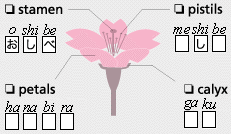
 The parts of the cherry blossom are written in roman letters. Try to complete the blanks with the proper hiragana character.
The parts of the cherry blossom are written in roman letters. Try to complete the blanks with the proper hiragana character.
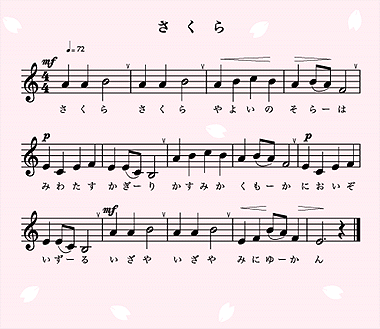
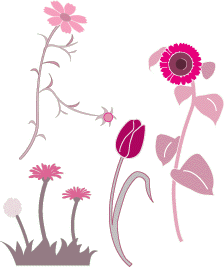 (2) Q & A about flowers
(2) Q & A about flowers




